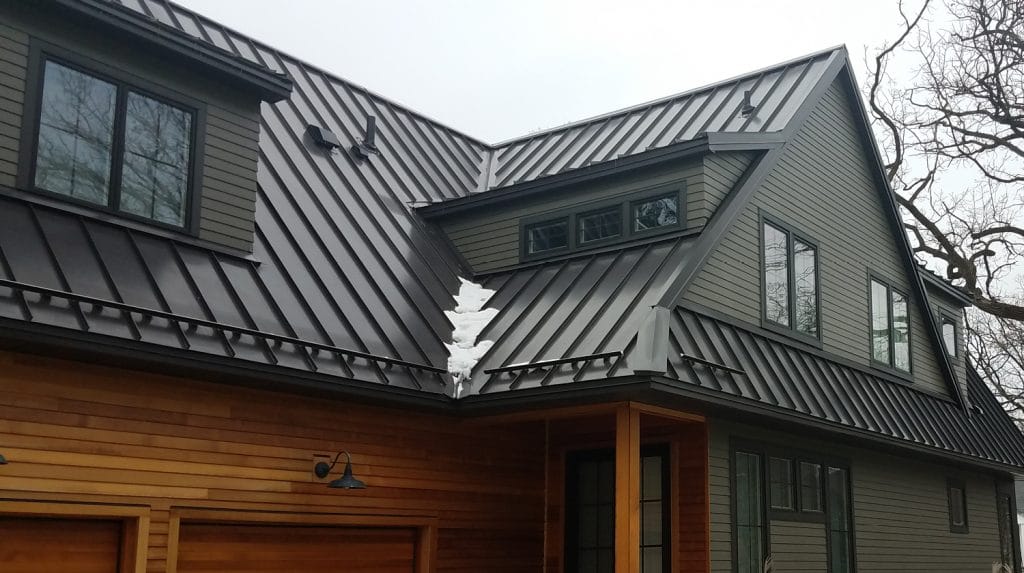Standing Seam Roofs on Residential Projects: The Pros and Cons
Standing seam metal roofs look sleek and modern, but they’re not always the best choice for a home. Here’s a balanced look at the pros and cons, plus a real client story that shows why asphalt, slate, or clay tiles might be better for most homeowners.

Over the last decade, standing seam metal roofs have become the “hot new” choice for residential projects. Their crisp vertical lines, wide color range, and association with high-end modern or farmhouse designs have made them a favorite for architects and homeowners alike.
A standing seam roof is made of continuous metal panels—often 12 to 18 inches wide—with raised seams (typically 1 to 2 inches tall) that run vertically from the ridge down to the eave. The panels are locked together with concealed fasteners, meaning there are no exposed screws to loosen over time. Most residential standing seam roofs are fabricated from painted galvanized steel or aluminum, though higher-end projects may use zinc or copper.
While they can be an excellent option in the right context, they’re not without drawbacks—and for many homes, a traditional asphalt shingle roof still makes more sense.
The Pros of Standing Seam Metal Roofs
- Longevity – Properly installed standing seam roofs can last 40–70 years depending on material. Steel panels are often 24-gauge or 26-gauge, with thicker gauges offering greater durability. Aluminum is ideal for coastal areas where salt corrosion is an issue.
- Low Maintenance – Concealed fasteners prevent the loosening and water penetration common with exposed fastener systems. Annual inspections are usually all that’s needed.
- Energy Efficiency – Many standing seam roofs can be ordered with “cool roof” finishes that meet ENERGY STAR® reflectivity standards, reducing attic temperatures in summer.
- Wind Resistance – When installed to manufacturer specifications, standing seam panels can be rated for winds up to 140 mph or more—ideal for hurricane-prone regions.
- Snow Shedding – The smooth metal surface encourages snow to slide off quickly, reducing ice dam risks in colder climates.
- Aesthetics – Available in dozens of colors and finishes, standing seam offers a clean, architectural look that works especially well on modern or contemporary designs.
The Cons of Standing Seam Metal Roofs
- Cost – Expect to pay $8–$14 per square foot installed, versus $3–$6 for architectural asphalt shingles. Custom fabrication, premium coatings, and complex roof shapes can drive the price even higher.
- Noise – Rain and hail can create a drumming effect on the panels. Even with a sound-deadening underlayment, it’s difficult to match the quiet of asphalt shingles.
- Thermal Movement – Metal expands and contracts as temperatures change, which can stress fasteners and flashing. Proper clip spacing and floating panel systems are essential.
- Specialized Installation – Standing seam requires precise tools and trained installers. Improper hemming, panel locking, or flashing details can lead to leaks.
- Over-Engineering for Typical Homes – The extreme durability of metal may exceed the life expectancy of the house itself, making the investment questionable for some projects.
A Real-World Example
A few years ago, my office worked with a client who was drawn to the clean lines of a standing seam roof. We planned carefully, specifying a 24-gauge Galvalume steel panel with a Kynar 500® finish for maximum corrosion resistance, and we added a high-density polyiso insulation layer between the roof deck and panels to reduce noise.
Despite our efforts, after the first heavy rain the client called us to say they were kept up all night by the sound of water hitting the metal. The insulation helped, but it wasn’t enough to replicate the quiet of an asphalt roof. For them, the roof’s beauty came at the cost of restful sleep.
Roofing Options at a Glance
| Feature / Metric | Asphalt Shingles | Standing Seam Metal | Slate / Clay Tile |
|---|---|---|---|
| Typical Lifespan | 20–30 years | 40–70 years | 75–150+ years |
| Installed Cost | $3–$6 / sq. ft. | $8–$14 / sq. ft. | $15–$30 / sq. ft. |
| Maintenance | Low, periodic inspection | Very low, periodic inspection | Very low, occasional broken tile repair |
| Wind Resistance | Good (up to ~110 mph) | Excellent (up to ~140+ mph) | Excellent (up to ~150 mph) |
| Noise in Rain | Very quiet | Moderate to loud | Very quiet |
| Weight on Structure | Light (~2–4 lbs/sq. ft.) | Light to moderate (~1.5–2.5 lbs/sq. ft.) | Heavy (~8–15 lbs/sq. ft.) – may require structural reinforcement |
| Fire Resistance | Good (Class A rated available) | Excellent (non-combustible) | Excellent (non-combustible) |
| Best For | Budget-conscious projects | Modern designs, high-wind/coastal homes | High-end, historic, or forever homes |
My Recommendation
If you love the look of standing seam and are prepared for the cost and potential noise, it can be a fantastic roof—especially on architecturally driven designs or homes in high-wind areas. If you live in a coastal region, aluminum standing seam can be a smart, corrosion-resistant choice. But for most residential projects, a high-quality architectural asphalt roof offers the best balance of cost, performance, and comfort.
And if you want to invest in a truly premium roof with exceptional longevity and quiet comfort, consider slate or clay tiles. Both can last a century or more, offer a classic appearance, and won’t turn every rainstorm into a percussion concert.
